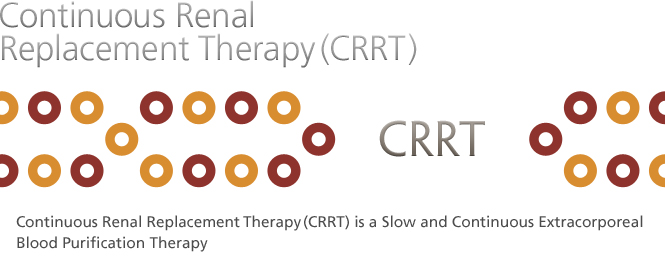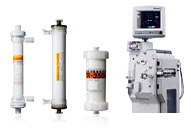- Overview
- Therapies
- Applied
Products - References
Continuous Renal Replacement Therapy (CRRT) is a slow and continuous extracorporeal blood purification therapy. CRRT mimics the functions of the kidneys in regulating water, electrolytes and toxic products by the continuous slow removal of solutes and fluid. CRRT is indicated in patients who meet criteria for hemodialysis therapy but cannot tolerate conventional intermittent hemodialysis (IHD) due to hemodynamic instability.
Significant decrease of circulating blood volume can be observed in IHD due to fast fluid removal and can increase the risk of hypotension. Slow and continuous removal of fluid in CRRT enables intravascular water refilling from tissue, and can minimize the negative impact on hemodynamic stability [1].
Slow and continuous removal of solutes facilitates the transfer of solutes from the tissue to the blood, and enables to remove the uremic toxins in the tissue along with the uremic toxins in the blood. CRRT using a high permeable hemofilter can remove high molecular weight solutes up to 30,000 Daltons, including humoral mediators involved in clinical status. It is speculated that removal of humoral mediators may be also beneficial to the improvement of the clinical status [2].
The contents of the replacement fluid can contribute to the correction of the acid-base balance and the electrolyte balance which is often disturbed in the critically ill patients needing CRRT [3].
[1] Ronco C, Brendolan A, Bellomo R. Online monitoring in continuous renal replacement therapies. Kidney Int Suppl. 1999;(72):S8-14.
[2] Heering P, Grabensee B, Brause M. Cytokine removal in septic patients with continuous venovenous hemofiltration. Kidney Blood Press Res. 2003;26:128-34.
[3] Uchino S, Bellomo R, Ronco C. Intermittent versus continuous renal replacement theraphy in the ICU: impact on electrolyte and acid-base balance. Intensive Care Med. 2001;27:1037-43.
CRRT is applied for patients with acute renal failure (ARF) who also suffer from severe complications, such as multiple organ failure or imperfections in their cardiac and circulatory system, such as cardiac insufficiency and oedema. In addition to renal failure, CRRT may also be applied for conditions like multiple organ failure, serve acute pancreatitis, fulminant hepatitis, postoperative liver failure.
- SCUF (Slow continuous ultra filtration)
- CVVH (Continuous venovenous hemofiltration )
- CVVHD ( Continuous venovenous hemodialysis )
- CVVHDF (Continuous venovenous hemodiafiltration)
Please feel free to send us any questions you may have about the therapy and related information.
Please feel free to send us any questions you may have about our products and support.
Share your feelings and experiences when using our products.





